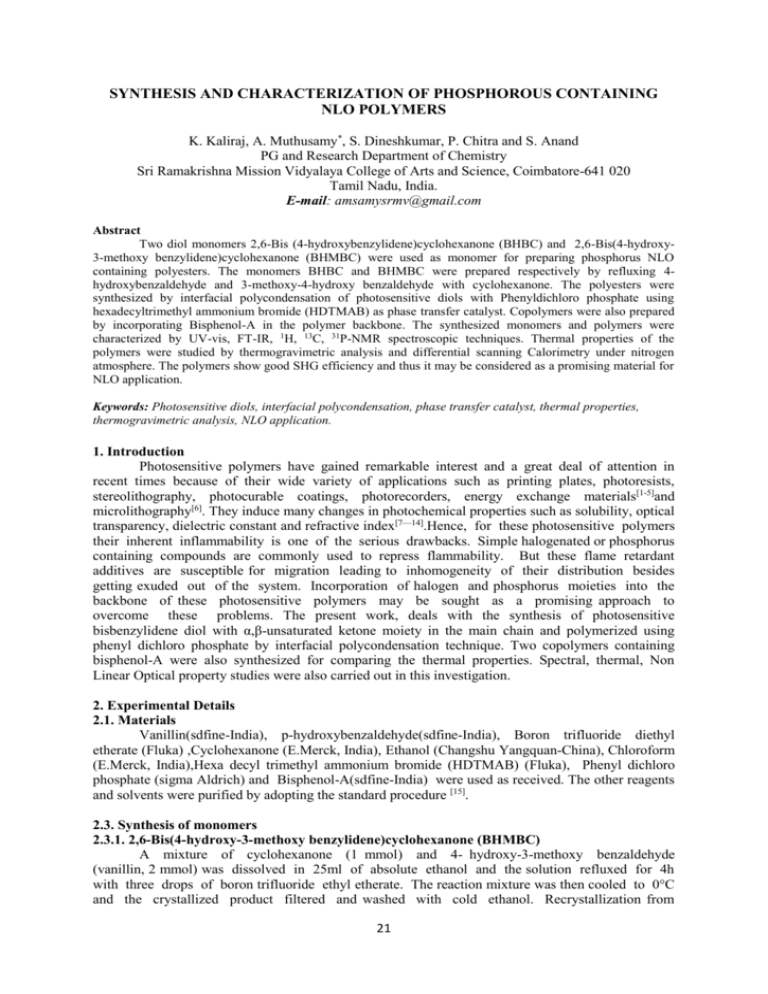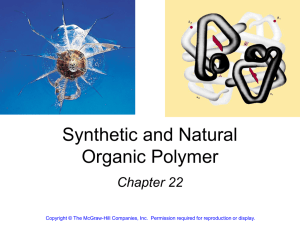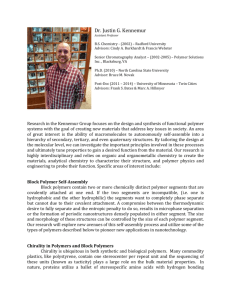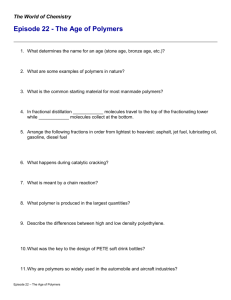6. K. Kaliraj, A. Muthusamy, 21
advertisement

SYNTHESIS AND CHARACTERIZATION OF PHOSPHOROUS CONTAINING NLO POLYMERS K. Kaliraj, A. Muthusamy*, S. Dineshkumar, P. Chitra and S. Anand PG and Research Department of Chemistry Sri Ramakrishna Mission Vidyalaya College of Arts and Science, Coimbatore-641 020 Tamil Nadu, India. E-mail: amsamysrmv@gmail.com Abstract Two diol monomers 2,6-Bis (4-hydroxybenzylidene)cyclohexanone (BHBC) and 2,6-Bis(4-hydroxy3-methoxy benzylidene)cyclohexanone (BHMBC) were used as monomer for preparing phosphorus NLO containing polyesters. The monomers BHBC and BHMBC were prepared respectively by refluxing 4hydroxybenzaldehyde and 3-methoxy-4-hydroxy benzaldehyde with cyclohexanone. The polyesters were synthesized by interfacial polycondensation of photosensitive diols with Phenyldichloro phosphate using hexadecyltrimethyl ammonium bromide (HDTMAB) as phase transfer catalyst. Copolymers were also prepared by incorporating Bisphenol-A in the polymer backbone. The synthesized monomers and polymers were characterized by UV-vis, FT-IR, 1H, 13C, 31P-NMR spectroscopic techniques. Thermal properties of the polymers were studied by thermogravimetric analysis and differential scanning Calorimetry under nitrogen atmosphere. The polymers show good SHG efficiency and thus it may be considered as a promising material for NLO application. Keywords: Photosensitive diols, interfacial polycondensation, phase transfer catalyst, thermal properties, thermogravimetric analysis, NLO application. 1. Introduction Photosensitive polymers have gained remarkable interest and a great deal of attention in recent times because of their wide variety of applications such as printing plates, photoresists, stereolithography, photocurable coatings, photorecorders, energy exchange materials[1-5]and microlithography[6]. They induce many changes in photochemical properties such as solubility, optical transparency, dielectric constant and refractive index[7—14].Hence, for these photosensitive polymers their inherent inflammability is one of the serious drawbacks. Simple halogenated or phosphorus containing compounds are commonly used to repress flammability. But these flame retardant additives are susceptible for migration leading to inhomogeneity of their distribution besides getting exuded out of the system. Incorporation of halogen and phosphorus moieties into the backbone of these photosensitive polymers may be sought as a promising approach to overcome these problems. The present work, deals with the synthesis of photosensitive bisbenzylidene diol with α,β-unsaturated ketone moiety in the main chain and polymerized using phenyl dichloro phosphate by interfacial polycondensation technique. Two copolymers containing bisphenol-A were also synthesized for comparing the thermal properties. Spectral, thermal, Non Linear Optical property studies were also carried out in this investigation. 2. Experimental Details 2.1. Materials Vanillin(sdfine-India), p-hydroxybenzaldehyde(sdfine-India), Boron trifluoride diethyl etherate (Fluka) ,Cyclohexanone (E.Merck, India), Ethanol (Changshu Yangquan-China), Chloroform (E.Merck, India),Hexa decyl trimethyl ammonium bromide (HDTMAB) (Fluka), Phenyl dichloro phosphate (sigma Aldrich) and Bisphenol-A(sdfine-India) were used as received. The other reagents and solvents were purified by adopting the standard procedure [15]. 2.3. Synthesis of monomers 2.3.1. 2,6-Bis(4-hydroxy-3-methoxy benzylidene)cyclohexanone (BHMBC) A mixture of cyclohexanone (1 mmol) and 4- hydroxy-3-methoxy benzaldehyde (vanillin, 2 mmol) was dissolved in 25ml of absolute ethanol and the solution refluxed for 4h with three drops of boron trifluoride ethyl etherate. The reaction mixture was then cooled to 0°C and the crystallized product filtered and washed with cold ethanol. Recrystallization from 21 ethanol gave more than 75% yield of fine yellowish green crystals of the title compound. Melting point 1790c [lit.179°C] [16].This monomer BHBC was prepared in a similar manner to BHMBC. Recrystallization from a 3:1 mixture of ethanol/water gave fine yellow crystals of the title monomer with 82% yield, m.p.278°C. 2.4. Synthesis of Polymers All the polymers were prepared by the interfacial polycondensation method using HDTMAB as a phase transfer catalyst [17]. A typical procedure for the synthesis of polymer 1 is as follows: in a solution of BHMBC (1 mmol) in 20 ml of aqueous NaOH (1 N), HDTMAB (2 wt.% of the diol) was dissolved, then 20 ml chloroform solution of phenyl dichloro phosphate (1 mmol), was added to this mixture with vigorous stirring at 200c. After 30 min of stirring the solid polymer obtained was filtered and washed with water and acetone. It was then dried to a constant weight invacuo at 500C, the yield was 80%. The other polymers and copolymers II-V were also prepared in similar manner. These polymers were soluble in chloroform, DMSO, THF, DMF, DMAC and insoluble in benzene, toluene and pentane. 2.5 Characterization Infrared spectra from 4000 to 600 cm-1 of solid samples of the synthesized monomers and polymers were obtained by KBr method using a PERKIN ELMER spectrophotometer. 1H-NMR spectra was run on JEOLGSX 400 MHz NMR spectrophotometer at room temperature (RT) in d4dimethylsulphoxide (DMSO) or CDCl3 using TMS as an internal reference. The UV–visible spectra of the polymers were scanned on a SYSTRONICS 2202 spectrophotometer in DMSO or CHCl 3. Thermo gravimetric analyses (TGA) of the polymers were examined in nitrogen atmosphere using a thermal analyzer (TA) PERKIN ELMER at a heating rate of 10 0C/min. Differential Scanning Calorimetry (DSC) was examined in nitrogen atmosphere using a PERKIN ELMER (thermal analyzer).Second harmonic generation test for the polymers was performed by the powder technique of Kurtz and Perry [18] using a pulsed Nd:YAG laser (Model: YG501C, l=1064 nm). Pulse energy of 4 mJ/pulse, pulse width of 10 ns and repetition rate of 10 Hz were used. 2.6 Non Linear Optical studies The presence of SHG in the synthesized polymer samples was confirmed by using the modified powder SHG test of Kurtz and Perry. The polymer samples were ground into powder particles of uniform size and packed in a glass container. A Q switched Nd:YAG laser is used as source for IR radiation of fundamental wavelength 1064 nm, 10 ns pulse width, 10Hz pulse rate and 2.5 mJ energy per pulse is made to fall on the sample uniformly. The SHG is confirmed by the emission of green radiation of wavelength 532 nm. The SHG efficiencies of the polymer samples were measured by keeping KDP and Urea as the reference material. 3. Results and discussion All the polymers were obtained by interfacial polycondensation method using a phase transfer catalyst at 200c with >75% yield (Scheme I). All the polymers were soluble in chloroform,tetrahydrofuran, dimethylformamide, dimethylsulfoxide, and dimethylacetamide and insoluble in benzene, toluene, and n-hexane. The good solubility in polar organic solvents may be attributed to the introduction of phosphorous segments in the polymer backbone [19].The results are summarized in table 1. The infrared spectrum of polymer Ishowed the absorption band near 3063 cm-1 corresponds to aromatic –CH stretching, 1665 and 1600 corresponds to cyclohexanone and exocyclic double bond stretching’s respectively. All the polymers show absorption around 1300 and 960 cm-1 corresponds to P═O and P–O–C (aromatic) stretching’s. These results support the formation of polyphosphate esters. 22 Scheme I Fig.1 TGA traces of polymer II 1 H-NMR spectrum of polymer I showed the aromatic protons of the main chain and pendent phenyl ring as a broad multiplet in the region of 6.4 to 7.1 δ. The signals corresponding to Olefinic protons appear at 7.5 δ. The βandγ methylene protons of cyclohexanone appear at around 2.87 δ and 1.8 δ respectively. The -CH3 protonsof bisphenol-A moiety in homo and copolymers appear in the range of 1.58-2.19 δ. These data strongly confirmed the formation of the polymers. Table 1 Yield and solubility data of polymers. Yield solvents Polymer % CHCl3 DMSO THF DMF DMAC C6H6 Toluene n-hexane I 80 + + + + + - - - II 78+ + + + + - - - - III 76+ + + + + - - - - IV 82+ + + + + - - - - V 79 + + + + + - - - The proton decoupled spectra 13C-NMR spectrum of polymer I shown in fig.2 the aromatic carbons of the main and side chains are in the region 115-150δ. The methoxy carbon resonates at 56δ. The thermal stability of the polymers was ascertained by thermogram. The TGA traces of the polymer II is shown in fig 1. All the polymers are stable up to 1000c and start degrading thereafter. The degradation occurs in two step process, the first corresponding to the formation of various small fragments, which subsequently carbonize in the second step. The temperature corresponding to 10% weight loss of polymer are in the range of 345oC whereas, the copolymer shows 300oC. The temperature for 10 and 50 % decomposition of homopolymer and copolymer, the char residue at 800oC indicates that the copolymer has less thermal stability than the homopolymer. 23 Fig.2 Proton decoupled 13C NMR Spectrum of polymer I The LOI values of the polymers are calculated using Van Krevelen’s equation. All the polymers show considerably higher LOI values than the threshold value and hence exhibit superior flame retardancy. The SHG conversion efficiency of the compound was measured by powder technique using Nd: YAG laser of wavelength 1064 nm. The laser power was 2.5mJ/s. All the polymers show good SHG efficiency and thus it may be considered as a promising material for NLO application. Conclusion Two new series of phosphorus containing homo and co-polyesters with photosensitive moietiesin the main chain were synthesized from2,6-Bis(4-hydroxy-3-methoxybenzylidene) cyclohexanone and2,6-Bis (4-hydroxybenzylidene)cyclohexanoneby interfacial polycondensation technique using HDTMAB as phase transfer catalyst. The structures ofsynthesized polymers were confirmed through UV, FTIR and 1H-NMR, 13C-NMR and31PNMR spectroscopic techniques. The presence of flexible P–O– C linkages provides good solubility in common organic solvents like DMF, DMSO and THF. Thermogravimetric results indicate that the synthesized polymers are stable up to 1000C and possess high char residue at 8000C. All the polymers show good SHG efficiency and thus it may be considered as a promising material for NLO application. References 1. S.C. Murugavel, C.S. Swaminathan and P. Kannan, Polymer, 38 (1997) 5179. 2. D. G. Borden, J. Appl. Polym. Sci., 22 (1978) 239. 3. V. Tenkovtsev, A.V. Yakimansky, M. M. Dudkina, V. V. Lukoshkin, H.Komber, L. Haussler and F. Bohme, Macromolecules, 34 (2001) 7100. 4. A. Bayer, V. Villiger, Ber. Dtsch. Chem. Ges., 35 (1902) 1189. 5. C. Reichardt, S. Asharin-Fard, A. Blum, M. Eschner, A.M. Mehranpour, P. Milart, T. Niem, G. Schafer and M. Wilk, Pure and Appl. Chem., 85(12) (1993) 2593. 6. R. M. Silverstein and F. X. Webster, “Spectroscopic Identification of Organic Compounds”, John Wiley & Sons, New York, VI Edn., (2003). 7. W. Kemp, “OrganicSpectroscopy”, ELBS, Hampshire, III Edn., (2003). 8. J. R. Dimnock, P. Kumar, A. J. Nazarali, N. L. Motaganahalli, T. P. Kowalchuk, M. A. Beazely, J. Wilson Quail, E. O. T. M. Allen, J. Szydlowski, E. DeClercq and J. Palzarini, Eur. J. Med. Chem., 35 (2000) 967. 9. P. J. Smith, J. R. Dimnock and W. A. Turner, Can. J. Chem, 51 (1973) 1458. 10. G. Venkateshwaralu and B. Subramanian, Proc. Indian Acad. Sci.(Chem.Sci.), 102(1) (1990) 45. 11. C. M. Devia, N. B. Pappano and N. B. Debattista, Rev. Microbiol., 29 (1998) 4. 12. A. Arun, B. S. R. Reddy and M. Rajkumar, J. Bioact. Compat. Polym., 8 (2003) 219. 13. P. W. Morgan, “Condensation Polymers by Interfacial and Solution Methods” Wiley Interscience, New York, (1965). 14. C. M. Starks and C. Liotta, “Phase transfer catalysis, principles and techniques”, Academic press, New York, (1973). 15. Perrin D D and Armarigo W L F Purification of Laboratory Chemicals, Pergamon Press, NewYork, (1988). 16. K. Balaji, S. C. Murugavel,J. Appl. Polym. Sci., 120, (2011) 3141–3150. 17. Moran P W Condensation Polymers by Interfacial and Solution Methods, Interscience, NewYork, (1965). 18. S.K. Kurtz, T.T. Perry, J. Appl. Phys. 39, (1968) 3798. 19. Y. Delaviz, Gungor, H.W. Gibson, Polymer, 34, (1993), 210. 24






